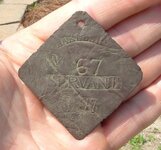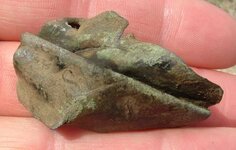SC Keith
Hero Member
- Aug 25, 2010
- 678
- 1,415
- 🥇 Banner finds
- 5
- Detector(s) used
- Minelab Excalibur II, XP Deus II
- Primary Interest:
- Relic Hunting
I dug this servant slave tag on May 8th at a plantation in South Carolina. The tag was folded over when I dug it, so I had it straightened by a professional. My friend Mark was with me when I dug it and had recovered his own servant tag, an 1811 servant, the week before at this same place.
This 1817 dated tag is an early date for the slave hire badges, since the earliest known date on any tag is the year 1800. The number 67 is the issue sequence for the occupation of servant which the city of Charleston, S.C. issued during that calender year. Thanks for looking!
Keith
This 1817 dated tag is an early date for the slave hire badges, since the earliest known date on any tag is the year 1800. The number 67 is the issue sequence for the occupation of servant which the city of Charleston, S.C. issued during that calender year. Thanks for looking!
Keith
Amazon Forum Fav 👍
Attachments
Upvote
3














